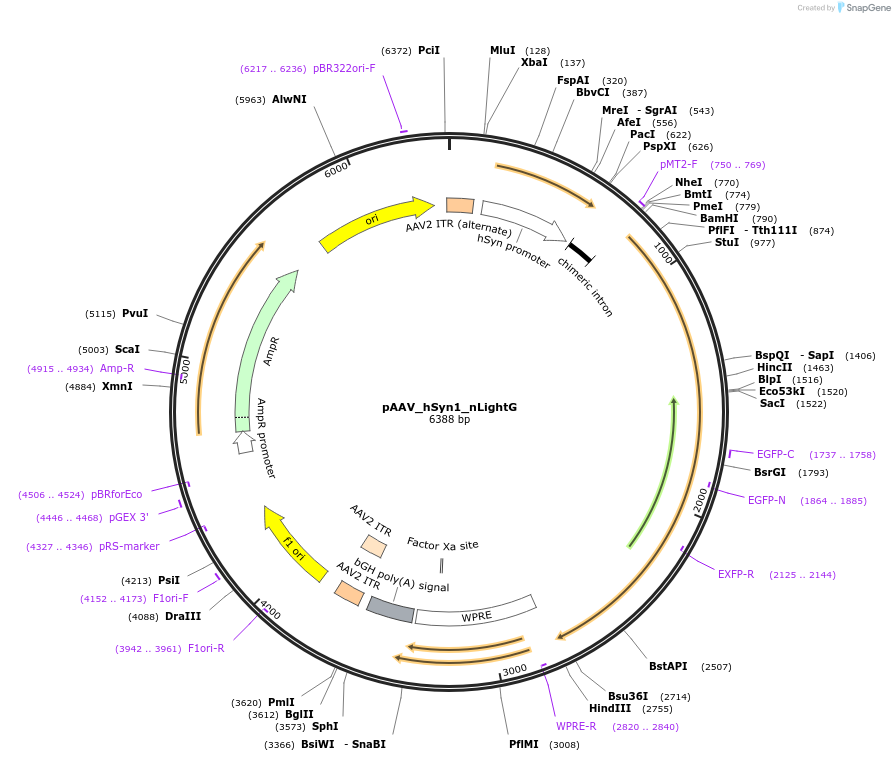-
PurposeExpresses green norepinephrine indicator nLightG in neuronal cells
-
Depositing Lab
-
Sequence Information
Ordering
| Item | Catalog # | Description | Quantity | Price (USD) | |
|---|---|---|---|---|---|
| Plasmid | 187179 | Standard format: Plasmid sent in bacteria as agar stab | 1 | $89 | |
| AAV9 | 187179-AAV9 | Virus (100 µL at titer ≥ 1×10¹³ vg/mL) and Plasmid. | $437 | ||
Don’t see the serotype you want?
Make a packaging request and we'll get back to you.
Please log in to submit a packaging request.
-
SerotypeSelect serotype for details See details about
-
PricingSelect serotype and quantity $ USD for preparation of µL virus + $32 USD for plasmid.
-
How this works
- Place a request for a quantity of 2 (0.2 mL), 10 (1 mL), 25 (2.5 mL), or 50 (5 mL). Our all-inclusive pricing includes DNA production and QC.
- Addgene will quickly confirm that we can produce a high-quality prep for you.
- Track your request and place an order from within your account. Payment information must be added before we can begin processing your order.
- Receive your prep in 6–9 weeks after the MTA is approved by your organization.
- Learn more about our Packaged on Request Service.
Backbone
-
Vector backbonepAAV.hSynapsin1
-
Backbone manufacturerViral Vector Facility - University of Zurich
- Backbone size w/o insert (bp) 4438
- Total vector size (bp) 6481
-
Vector typeAAV
Growth in Bacteria
-
Bacterial Resistance(s)Ampicillin, 100 μg/mL
-
Growth Temperature30°C
-
Growth Strain(s)NEB Stable
-
Copy numberUnknown
Gene/Insert
-
Gene/Insert namenLightG
-
SpeciesSynthetic
-
Insert Size (bp)1950
-
GenBank ID
- Promoter human Synapsin-1
-
Tag
/ Fusion Protein
- Flag tag (N terminal on insert)
Cloning Information
- Cloning method Restriction Enzyme
- 5′ cloning site BamHI (not destroyed)
- 3′ cloning site HindIII (not destroyed)
- 5′ sequencing primer ctattggtcttactgacatccactttg
- 3′ sequencing primer aggagaaaatgaaagccatacggg
- (Common Sequencing Primers)
Resource Information
-
Supplemental Documents
Terms and Licenses
-
Academic/Nonprofit Terms
-
Industry Terms
- Not Available to Industry
Trademarks:
- Zeocin® is an InvivoGen trademark.
Information for AAV9 (Catalog # 187179-AAV9) ( Back to top)
Purpose
Ready-to-use AAV9 particles produced from pAAV_hSyn1_nLightG (#187179). In addition to the viral particles, you will also receive purified pAAV_hSyn1_nLightG plasmid DNA.
Synapsin-driven expression of norepinephrine sensor nLightG. These AAV preparations are suitable purity for injection into animals.Delivery
- Volume 100 µL
- Titer ≥ 1×10¹³ vg/mL
- Pricing $405 USD for preparation of 100 µL virus + $32 USD for plasmid.
- Storage Store at -80℃. Thaw just before use and keep on ice.
- Shipment Viral particles are shipped frozen on dry ice. Plasmid DNA (≥ 200ng) will also be included in the shipment.
Viral Production & Use
- Packaging Plasmids encode adenoviral helper sequences and AAV rep gene, AAV9 cap gene
- Buffer PBS + 0.001% Poloxamer 188
- Serotype AAV9
- Purification Iodixanol gradient ultracentrifugation
Biosafety
Requestor is responsible for compliance with their institution's biosafety regulations. Lentivirus is generally considered BSL-2. AAV is generally considered BSL-1, but may require BSL-2 handling depending on the insert. Biosafety Guide
Terms and Licenses
-
Academic/Nonprofit Terms
-
Industry Terms
- Not Available to Industry
Viral Quality Control
- Addgene ensures high quality viral vectors by optimizing and standardizing production protocols and performing rigorous quality control (QC) (see a list of our QC assays). The specific QC assays performed varies for each viral lot. To learn which specific QC assays were performed on your lot, please contact us.
- Titer: the exact titer of your sample will be reported on the tube. The titer you see listed on this page is the guaranteed minimum titer. See how titers are measured.
Visit our viral production page for more information.
These plasmids were created by your colleagues. Please acknowledge the Principal Investigator, cite the article in which the plasmids were described, and include Addgene in the Materials and Methods of your future publications.
-
For your Materials & Methods section:
pAAV_hSyn1_nLightG was a gift from Tommaso Patriarchi (Addgene plasmid # 187179 ; http://n2t.net/addgene:187179 ; RRID:Addgene_187179) For viral preps, please replace (Addgene plasmid # 187179) in the above sentence with: (Addgene viral prep # 187179-AAV9) -
For your References section:
Sensitive multicolor indicators for monitoring norepinephrine in vivo. Kagiampaki Z, Rohner V, Kiss C, Curreli S, Dieter A, Wilhelm M, Harada M, Duss SN, Dernic J, Bhat MA, Zhou X, Ravotto L, Ziebarth T, Wasielewski LM, Sonmez L, Benke D, Weber B, Bohacek J, Reiner A, Wiegert JS, Fellin T, Patriarchi T. Nat Methods. 2023 Sep;20(9):1426-1436. doi: 10.1038/s41592-023-01959-z. 10.1038/s41592-023-01959-z PubMed 37474807




